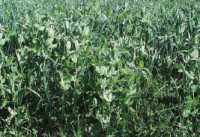



Bringing Back the Cows With Swath Grazing
By Don Comis, United States Department of Agriculture, Agricultural Research Service. This research is part of Integrated Farming Systems, an ARS national program (#207).Swath grazing is a way to revive the once widespread practice of letting cattle graze all winter in the Northern Plains. With swath grazing, farmers pile crop residue into rows, known as “swaths,” that stand as high as 16 inches. Cattle can usually push with ease through up to 2 feet of snow to graze on these crop residues or other high quality forages.
Northern Plains farmers and ranchers largely gave up the historical practice of grazing cattle on pastures or rangelands year-round in the late 1800s, after two severe winters caused extensive cattle losses from blizzards and a lack of reserve feed supplies.
But swath grazing, backed up by supplemental harvested grain, saves farmers money and labor compared to feeding cows hay in a corral near a barn during winter.
A Quarter Per Cow, Per Day

Soil scientist Don Tanaka and colleagues at the ARS Northern Great Plains Research Laboratory in Mandan, North Dakota, conducted a 4-year research project that showed farmers could save as much as 24 cents per cow, per day, by swath grazing from mid-November through mid-February. A farmer with a herd of 200 cows could save more than $4,000 in feed costs a year.
Swath grazing also helps farmers by eliminating the need to remove and store manure from winter cattle corrals. Instead, the cattle distribute the manure naturally, as they graze, improving soil quality and crop production.
The disadvantages are seen when ice or deep snow prevents cows from reaching the swathed residue. But those problems can be solved by mechanically breaking up the ice or snow.
Providing swathed forage for wintering pregnant beef cows was part of the study, in which scientists also sought to test a 3-year crop rotation to minimize use of store-bought nitrogen fertilizer and pesticides. They also wanted to determine the impact of livestock presence on no-till grain and forage production, whether for sale or to feed livestock.
The rotation used an oat and pea mix the first year, then a triticale and sweet clover mix, followed by drilled corn the third year. All were grown without tillage, and crop residue was left in swaths for livestock grazing.
The combination of no-till and annual crop rotations can give farmers higher yields, more agricultural stability, fewer crop pests, more protection against drought, less soil erosion, and more efficient use of precipitation. Farmers can also slash nitrogen fertilizer needs in half by planting legumes like clover and using nutrients in manure more efficiently.
Winters Are Costly for Pregnant Cows

In each year of the study, the scientists used 20 pregnant Hereford beef cows due to give birth in March. Pregnant cows need higher quality forage, and that need increases as pregnancy advances. This makes the winter feeding of pregnant cows the most expensive part of raising beef cattle.
The scientists rotationally grazed the cows on swathed oat and pea residue, then on swathed triticale and sweet clover residue, and last on swathed drilled corn. They compared those cows with others grazing swaths of western wheatgrass or feeding on baled mixed grass hay conventionally, in corrals.
“We found that the swathed forage was at least as protein rich as the baled hay, and the cows had slightly better weight gains with swath grazing annual crops,” says Scott Kronberg. He’s an ARS animal nutritionist who is part of the Mandan ARS team conducting this study, along with soil scientist Mark Liebig, rangeland scientist Jon Hanson, animal scientist Eric Scholljegerdes, and Jim Karn, an animal scientist who has since retired.
“The nice thing about this type of diversified and flexible integrated crop/ livestock system is that it provides the opportunity for producers to include legumes as cover crops, which can supply nitrogen to the soil. This benefits both the crops—by raising their yields—and the cattle, by boosting the protein in their feed,” Tanaka says.
A Crop for All Reasons

To solve the problem of millions of acres of grazing cropland in the northern Great Plains being ecologically degraded and under-producing, Tanaka and colleagues seek innovative ways—like swath grazing—to better integrate crop, forage, and livestock systems to make them economically and environmentally sustainable.
Hanson, who leads research at the Mandan lab, calls this “dynamic farming.” He and colleagues offer farmers more than a dozen crops to choose from each year, with more than 100 possible rotation combinations. Hanson says, “All of this was made possible in the Great Plains by the introduction of no-till and related conservation-tillage techniques, which leave a cover of unharvested plant parts to slow moisture evaporation from the soil. This means there’s enough moisture in the soil to sustain crops just about every year.”
These diverse cropping systems for forage and grain production include cool-season annual crops, such as oats, peas, and triticale; warm-season annuals, such as corn; and biennial (short-lived perennials) legumes, such as sweet clover. This diverse mix allows farmers to use crops that take advantage of erratic rainfall in the northern Great Plains.
“Adding diversity brings sustainability to farms, both economically and environmentally,” says Hanson.
Including livestock in the mix is probably the most important way to create this stability. Bringing cows back to graze on family farms year-round is a natural, easy, and profitable way to recycle manure as a soil conditioner, and it helps both soil and crops make the best use of precious, but erratic, precipitation.


